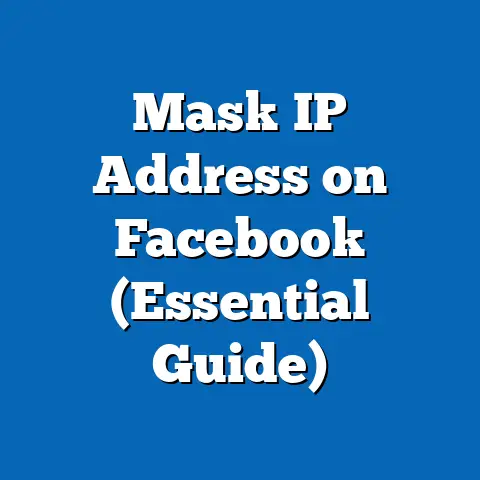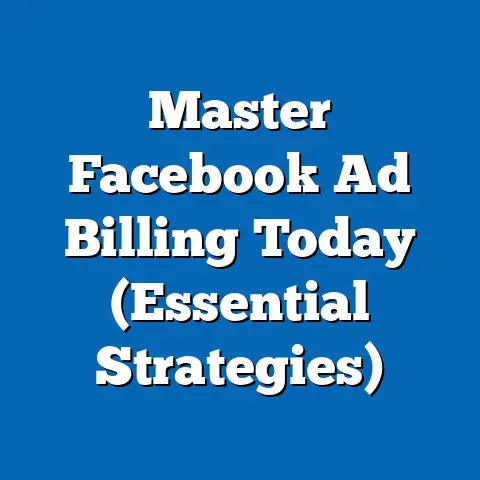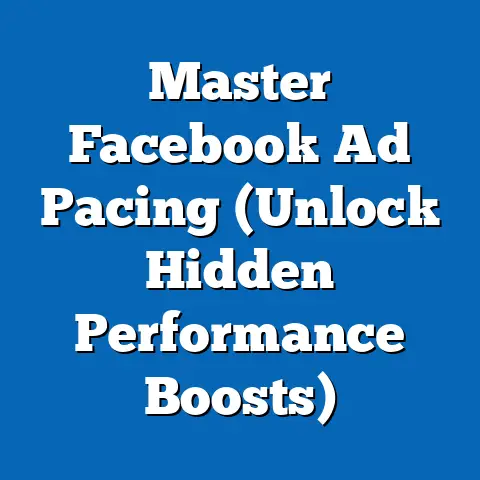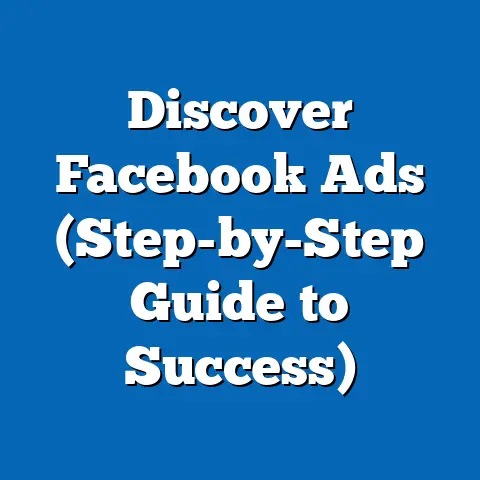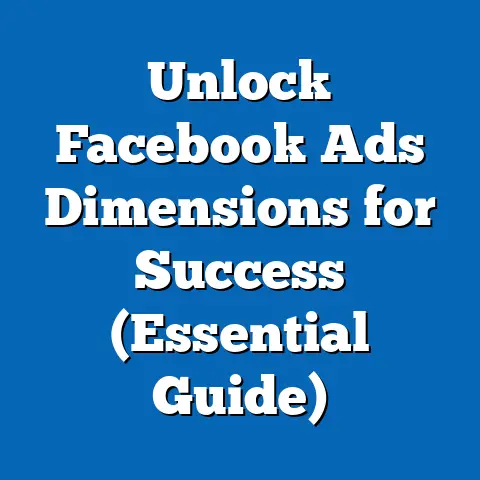Unblock Facebook Ads for Maximum Engagement (Savvy Tactics)
Facebook advertising. It’s a landscape I’ve navigated for years, witnessing firsthand the incredible potential it holds – and the frustrating plateaus we all hit. I remember one campaign for a local bakery. We were targeting a seemingly perfect audience, the visuals were mouthwatering, but engagement was…flat. It felt like our ads were shouting into a void. That experience, and countless others, taught me the absolute necessity of understanding not just how to run ads, but how to make them truly resonate.
Today, businesses are waking up to the fact that Facebook advertising isn’t just about quick sales; it’s about building a sustainable online presence that elevates brand visibility and cultivates genuine customer loyalty. Think of it like this: effective Facebook ads are like planting seeds in fertile ground. They might not sprout overnight, but with consistent care and the right approach, they’ll blossom into a thriving garden of engaged customers.
The reality is, brands with a strong, active Facebook presence command a higher “resale value,” whether they’re looking to attract investors, potential buyers, or simply build long-term equity. A brand that can consistently generate high engagement, positive sentiment, and a loyal following is inherently more valuable than one that relies solely on fleeting trends or paid promotions.
That’s why I’m excited to share some savvy tactics I’ve learned over the years to “unblock” your Facebook ads and maximize engagement. These aren’t just theoretical concepts; they’re practical strategies you can implement today to breathe life into your campaigns and achieve a better ROI. It’s about moving beyond simply showing ads to creating meaningful connections with your target audience. Let’s dive in.
Understanding Facebook Ads
Before we can unlock the secrets to engagement, let’s make sure we’re all on the same page about what Facebook Ads actually are. In essence, Facebook Ads are paid messages that businesses display to users on Facebook and Instagram (and the broader Meta network). They’re a powerful tool for reaching specific audiences, driving traffic to your website, generating leads, and ultimately, increasing sales.
The importance of Facebook Ads in today’s digital marketing landscape cannot be overstated. With billions of active users, Facebook offers unparalleled reach and targeting capabilities. It allows you to connect with potential customers based on demographics, interests, behaviors, and even their connections.
Types of Facebook Ads and Their Advantages:
Over the years, Facebook has evolved its ad formats to cater to diverse marketing objectives. Here are some of the most common types I’ve worked with, along with their unique advantages:
- Image Ads: These are the simplest form of Facebook Ads, featuring a single image and accompanying text. They’re great for showcasing products, promoting events, or simply raising brand awareness. Their simplicity makes them quick to create and easy to test different visuals.
- Video Ads: Video Ads are incredibly engaging, allowing you to tell a story, demonstrate a product, or share a testimonial. They’re particularly effective for capturing attention in the busy newsfeed and can lead to higher conversion rates. I’ve found short, impactful videos (under 15 seconds) tend to perform best.
- Carousel Ads: Carousel Ads allow you to display multiple images or videos in a single ad unit, each with its own headline, description, and link. They’re ideal for showcasing a range of products, highlighting different features of a single product, or telling a story in a sequential format.
- Collection Ads: Collection Ads are designed for e-commerce businesses, allowing users to browse and purchase products directly from the ad. They feature a main image or video, followed by a selection of related products. This format provides a seamless shopping experience and can drive significant sales.
- Lead Ads: Lead Ads are specifically designed to collect leads directly within Facebook. They feature a form that users can fill out without leaving the platform, making it incredibly convenient for them to provide their information. These are invaluable for building your email list or generating qualified leads for your sales team.
- Instant Experience Ads: These are full-screen, mobile-optimized experiences that open when someone clicks on your ad. They can include videos, images, carousels, and text, offering a highly immersive and engaging way to showcase your brand or product.
The Facebook Ads Manager:
At the heart of every successful Facebook advertising campaign lies the Facebook Ads Manager. This is the central hub where you create, manage, and optimize your ads. It provides a wealth of tools and features, including:
- Campaign Creation: The Ads Manager guides you through the process of setting up your campaign, choosing your objective, defining your target audience, setting your budget, and selecting your ad placements.
- Ad Creation: Within the Ads Manager, you can create your individual ads, choosing your ad format, uploading your visuals, writing your copy, and adding your call-to-action.
- Audience Targeting: The Ads Manager offers incredibly granular targeting options, allowing you to reach specific demographics, interests, behaviors, and more.
- Budget Management: You can set daily or lifetime budgets for your campaigns and ads, ensuring that you stay within your allocated spending limits.
- Performance Tracking: The Ads Manager provides detailed reports on your ad performance, including metrics like impressions, reach, engagement, click-through rates, conversions, and cost per result.
- Optimization: Using the data from your performance reports, you can optimize your ads by adjusting your targeting, refining your copy, testing different visuals, and making other changes to improve your results.
Takeaway: Understanding the fundamentals of Facebook Ads and the capabilities of the Ads Manager is crucial for creating effective campaigns that resonate with your target audience. Experiment with different ad formats, leverage the targeting options, and continuously monitor your performance to optimize your results.
The Importance of Engagement
So, we know what Facebook Ads are, but why is engagement so critical? Simply put, engagement is the lifeblood of any successful Facebook advertising campaign. It’s the measure of how well your ads are resonating with your target audience and driving them to take action.
In the context of Facebook Ads, engagement refers to the various ways users interact with your ads. This includes:
- Likes: A simple expression of approval or interest.
- Shares: When users share your ad with their own network, expanding its reach organically.
- Comments: A direct form of interaction, allowing users to ask questions, share opinions, or provide feedback.
- Click-Through Rates (CTR): The percentage of users who see your ad and click on the link to your website or landing page.
- Saves: When users save your ad to view later, indicating a strong interest in your offer.
Why Engagement Matters:
Engagement is more than just a vanity metric. It’s a powerful indicator of ad quality and relevance. Here’s why it matters:
- Improved Ad Performance: Facebook’s algorithm rewards ads with high engagement rates by showing them to more users and lowering their cost per result.
- Lower Costs per Conversion: When your ads are engaging, users are more likely to click on them, visit your website, and make a purchase. This translates to lower costs per conversion and a higher return on investment.
- Increased Brand Awareness: Engaging ads generate more visibility and reach, helping to build brand awareness and recognition.
- Stronger Customer Relationships: When users interact with your ads through likes, shares, and comments, it creates an opportunity to build stronger relationships with them. You can respond to their questions, address their concerns, and provide valuable information, fostering a sense of community and loyalty.
- Valuable Feedback: Comments on your ads can provide valuable feedback about your products, services, and marketing messages. This feedback can help you improve your offerings and refine your campaigns.
Key Metrics for Measuring Engagement:
To track the effectiveness of your Facebook Ads, it’s essential to monitor key engagement metrics. Here are some of the most important ones:
- Engagement Rate: This is the percentage of users who saw your ad and engaged with it (liked, shared, commented, clicked). A higher engagement rate indicates that your ad is resonating well with your target audience.
- Click-Through Rate (CTR): This is the percentage of users who saw your ad and clicked on the link. A high CTR indicates that your ad is compelling and relevant to the user’s interests.
- Cost Per Click (CPC): This is the amount you pay each time someone clicks on your ad. A lower CPC indicates that your ad is efficient and cost-effective.
- Cost Per Engagement (CPE): This is the amount you pay for each engagement (like, share, comment, click). A lower CPE indicates that your ad is generating engagement at a reasonable cost.
Takeaway: Engagement is the key to unlocking the full potential of your Facebook Ads. By focusing on creating engaging content, targeting the right audience, and monitoring your performance metrics, you can improve your ad performance, lower your costs, and build stronger customer relationships.
I’ve compiled a list of tactics that have consistently delivered results for me and my clients over the years.A. Audience Targeting:
- The Importance of Precise Audience Targeting: One of the biggest mistakes I see businesses make is targeting too broadly. It’s like casting a wide net in a vast ocean – you might catch something, but it’s unlikely to be the specific fish you’re after. Facebook’s Audience Insights tool is your best friend here. It allows you to delve deep into the demographics, interests, behaviors, and lifestyles of your target audience. I once used Audience Insights to discover that my ideal customer for a fitness product wasn’t just interested in “fitness,” but also in “organic food” and “outdoor activities.” This insight allowed me to refine my targeting and significantly improve my ad performance.
- Creating Custom Audiences and Lookalike Audiences: Custom Audiences allow you to target people who have already interacted with your business, such as website visitors, email subscribers, or customers. Lookalike Audiences, on the other hand, allow you to target people who are similar to your existing customers. This is a powerful way to expand your reach and find new customers who are likely to be interested in your products or services. I’ve seen tremendous success with Lookalike Audiences, often achieving conversion rates that are significantly higher than those of broad targeting campaigns.
B. Compelling Visuals:
- The Significance of High-Quality Visuals: In the fast-paced world of social media, visuals are your first (and often only) opportunity to capture attention. High-quality images and videos are essential for making a strong first impression and drawing users in. Think about it: when you’re scrolling through your Facebook feed, what makes you stop and pay attention? It’s usually a captivating visual that grabs your eye. I’ve found that investing in professional photography or videography can make a huge difference in ad performance.
- Tips on Using Colors, Fonts, and Images Effectively: Colors can evoke emotions and create a specific mood. Use colors that are consistent with your brand and that appeal to your target audience. Fonts should be easy to read and visually appealing. Avoid using too many different fonts in a single ad. Images should be relevant to your offer and visually engaging. Use high-resolution images that are well-composed and properly lit. I once ran an A/B test on two identical ads, one with a bright, vibrant color scheme and the other with a more muted, subdued palette. The vibrant ad outperformed the muted ad by a significant margin, demonstrating the power of color in capturing attention.
C. Crafting Attention-Grabbing Copy:
- Writing Compelling Ad Copy: Your ad copy is your opportunity to tell a story, highlight the benefits of your offer, and persuade users to take action. It should be clear, concise, and compelling. Use strong verbs, vivid language, and a conversational tone. Address the user’s pain points and explain how your product or service can solve their problems. I always start by identifying the single most important benefit of my offer and then crafting my copy around that benefit.
- The Importance of Strong Calls-to-Action (CTAs): A strong call-to-action (CTA) is essential for driving engagement and conversions. Tell users exactly what you want them to do, whether it’s “Learn More,” “Shop Now,” “Sign Up,” or “Get a Free Quote.” Use action-oriented language and make your CTA button visually prominent. I’ve found that using a sense of urgency in my CTAs (e.g., “Limited Time Offer”) can significantly increase click-through rates.
D. Utilizing A/B Testing:
- The Concept of A/B Testing: A/B testing (also known as split testing) is the process of comparing two versions of an ad to see which one performs better. You can A/B test different elements of your ads, such as visuals, copy, CTAs, and targeting options. This allows you to identify the most effective combinations and optimize your campaigns for maximum engagement.
- Running Effective A/B Tests: To run an effective A/B test, you need to change only one element at a time. This allows you to isolate the impact of that specific element and determine whether it’s improving or hurting your performance. Make sure to run your A/B tests for a sufficient amount of time (at least a few days) to gather enough data to draw meaningful conclusions. I typically use Facebook’s built-in A/B testing tool, which makes it easy to set up and track your tests.
E. Leveraging Social Proof:
- Using Testimonials, Reviews, and User-Generated Content: Social proof is a powerful psychological phenomenon that influences people’s decisions. When people see that others are using and enjoying your products or services, they’re more likely to trust your brand and make a purchase. Incorporate testimonials, reviews, and user-generated content into your ads to build trust and credibility. I’ve had great success featuring customer testimonials in my video ads. Seeing real people rave about my products has a much stronger impact than simply stating the benefits myself.
- Showcasing Social Proof to Build Trust: Make sure your testimonials and reviews are authentic and believable. Avoid using fake or overly enthusiastic testimonials. Encourage your customers to leave reviews on your Facebook page and other online platforms. You can also run contests and giveaways to encourage users to create and share user-generated content.
F. Timing and Frequency:
- The Importance of Timing in Ad Placements: The timing of your ad placements can significantly impact engagement. Consider when your target audience is most active on Facebook and Instagram. You can use Facebook’s ad scheduling feature to show your ads during those peak hours. I’ve found that posting in the late afternoon or early evening tends to work well for many audiences.
- Managing Ad Frequency to Avoid Ad Fatigue: Ad frequency refers to the number of times a user sees your ad. If a user sees your ad too many times, they may become annoyed and start to ignore it. This is known as ad fatigue. To avoid ad fatigue, you need to manage your ad frequency carefully. You can do this by setting frequency caps in your ad settings. I typically aim for a frequency of no more than 3-4 times per week per user.
Takeaway: These tactics are your arsenal for unblocking Facebook ads. Remember to tailor them to your specific business, target audience, and marketing objectives. Experiment, track your results, and continuously refine your approach to maximize engagement.
Analyzing and Adjusting Strategies
Creating engaging Facebook ads isn’t a “set it and forget it” process. It’s an ongoing cycle of analysis, adjustment, and optimization. The key is to continuously monitor your ad performance using Facebook Insights and use that data to refine your strategies.
Facebook Insights provides a wealth of information about your ad performance, including:
- Reach and Impressions: How many people saw your ad and how many times it was displayed.
- Engagement: The number of likes, shares, comments, and clicks your ad received.
- Click-Through Rate (CTR): The percentage of users who clicked on your ad.
- Cost Per Click (CPC): The amount you paid for each click.
- Conversions: The number of desired actions (e.g., purchases, sign-ups, leads) that resulted from your ad.
- Demographics: The age, gender, location, and interests of the people who saw your ad.
Analyze this data to understand what’s working and what’s not. Are your ads resonating with your target audience? Are you driving enough traffic to your website? Are you achieving your desired conversion rates?
Based on your analysis, be flexible and ready to adjust your strategies. This might involve:
- Refining your targeting: If your ads aren’t reaching the right people, you may need to adjust your targeting options.
- Tweaking your ad copy: If your ad copy isn’t compelling enough, you may need to rewrite it.
- Testing different visuals: If your visuals aren’t capturing attention, you may need to try different images or videos.
- Adjusting your budget: If you’re not achieving your desired results, you may need to increase or decrease your budget.
- Pausing or deleting underperforming ads: Don’t be afraid to cut your losses and focus on the ads that are delivering results.
Takeaway: Continuous monitoring and analysis are crucial for maximizing the effectiveness of your Facebook Ads. Be data-driven, flexible, and always be willing to experiment and adapt.
Conclusion
Unlocking maximum engagement on Facebook Ads is a journey, not a destination. It requires a strategic approach, a willingness to experiment, and a commitment to continuous learning. By implementing the savvy tactics I’ve shared in this article, you can significantly improve your engagement, lower your costs, and build stronger relationships with your target audience.
Remember, it’s not just about showing ads; it’s about creating meaningful connections. Focus on understanding your audience, crafting compelling content, and leveraging the power of social proof.
By taking action and optimizing your Facebook Ads today, you can unlock their full potential and achieve better results for your business. So, go out there, experiment, and start engaging!
Call to Action:
I’d love to hear about your experiences with Facebook Ads! Share your thoughts, ask questions, or seek further insights on maximizing your ad engagement in the comments below. Let’s learn and grow together! What are your biggest challenges with Facebook ads? What strategies have worked best for you? I’m eager to hear your stories and help you on your journey to Facebook advertising success.

